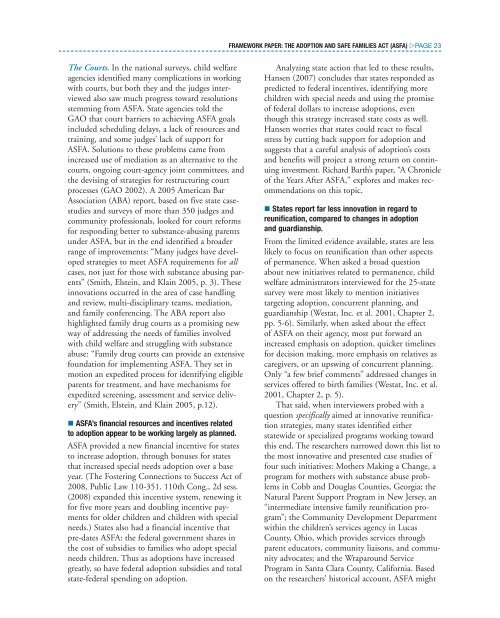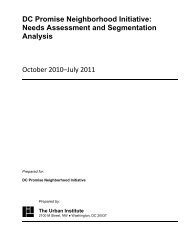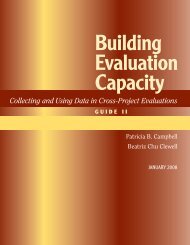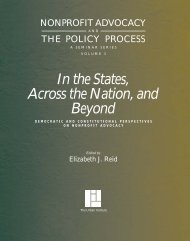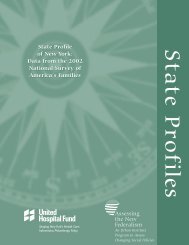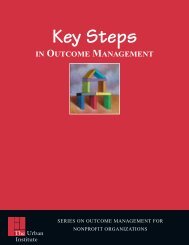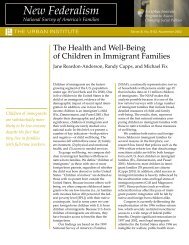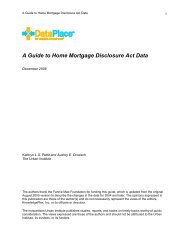Intentions and Results: A Look Back at the Adoption ... - Urban Institute
Intentions and Results: A Look Back at the Adoption ... - Urban Institute
Intentions and Results: A Look Back at the Adoption ... - Urban Institute
Create successful ePaper yourself
Turn your PDF publications into a flip-book with our unique Google optimized e-Paper software.
The Courts. In <strong>the</strong> n<strong>at</strong>ional surveys, child welfare<br />
agencies identified many complic<strong>at</strong>ions in working<br />
with courts, but both <strong>the</strong>y <strong>and</strong> <strong>the</strong> judges interviewed<br />
also saw much progress toward resolutions<br />
stemming from ASFA. St<strong>at</strong>e agencies told <strong>the</strong><br />
GAO th<strong>at</strong> court barriers to achieving ASFA goals<br />
included scheduling delays, a lack of resources <strong>and</strong><br />
training, <strong>and</strong> some judges’ lack of support for<br />
ASFA. Solutions to <strong>the</strong>se problems came from<br />
increased use of medi<strong>at</strong>ion as an altern<strong>at</strong>ive to <strong>the</strong><br />
courts, ongoing court-agency joint committees, <strong>and</strong><br />
<strong>the</strong> devising of str<strong>at</strong>egies for restructuring court<br />
processes (GAO 2002). A 2005 American Bar<br />
Associ<strong>at</strong>ion (ABA) report, based on five st<strong>at</strong>e casestudies<br />
<strong>and</strong> surveys of more than 350 judges <strong>and</strong><br />
community professionals, looked for court reforms<br />
for responding better to substance-abusing parents<br />
under ASFA, but in <strong>the</strong> end identified a broader<br />
range of improvements: “Many judges have developed<br />
str<strong>at</strong>egies to meet ASFA requirements for all<br />
cases, not just for those with substance abusing parents”<br />
(Smith, Elstein, <strong>and</strong> Klain 2005, p. 3). These<br />
innov<strong>at</strong>ions occurred in <strong>the</strong> area of case h<strong>and</strong>ling<br />
<strong>and</strong> review, multi-disciplinary teams, medi<strong>at</strong>ion,<br />
<strong>and</strong> family conferencing. The ABA report also<br />
highlighted family drug courts as a promising new<br />
way of addressing <strong>the</strong> needs of families involved<br />
with child welfare <strong>and</strong> struggling with substance<br />
abuse: “Family drug courts can provide an extensive<br />
found<strong>at</strong>ion for implementing ASFA. They set in<br />
motion an expedited process for identifying eligible<br />
parents for tre<strong>at</strong>ment, <strong>and</strong> have mechanisms for<br />
expedited screening, assessment <strong>and</strong> service delivery”<br />
(Smith, Elstein, <strong>and</strong> Klain 2005, p.12).<br />
� ASFA’s financial resources <strong>and</strong> incentives rel<strong>at</strong>ed<br />
to adoption appear to be working largely as planned.<br />
ASFA provided a new financial incentive for st<strong>at</strong>es<br />
to increase adoption, through bonuses for st<strong>at</strong>es<br />
th<strong>at</strong> increased special needs adoption over a base<br />
year. (The Fostering Connections to Success Act of<br />
2008, Public Law 110-351. 110th Cong., 2d sess.<br />
(2008) exp<strong>and</strong>ed this incentive system, renewing it<br />
for five more years <strong>and</strong> doubling incentive payments<br />
for older children <strong>and</strong> children with special<br />
needs.) St<strong>at</strong>es also had a financial incentive th<strong>at</strong><br />
pre-d<strong>at</strong>es ASFA: <strong>the</strong> federal government shares in<br />
<strong>the</strong> cost of subsidies to families who adopt special<br />
needs children. Thus as adoptions have increased<br />
gre<strong>at</strong>ly, so have federal adoption subsidies <strong>and</strong> total<br />
st<strong>at</strong>e-federal spending on adoption.<br />
FRAMEWORK PAPER: THE ADOPTION AND SAFE FAMILIES ACT (ASFA) �PAGE 23<br />
Analyzing st<strong>at</strong>e action th<strong>at</strong> led to <strong>the</strong>se results,<br />
Hansen (2007) concludes th<strong>at</strong> st<strong>at</strong>es responded as<br />
predicted to federal incentives, identifying more<br />
children with special needs <strong>and</strong> using <strong>the</strong> promise<br />
of federal dollars to increase adoptions, even<br />
though this str<strong>at</strong>egy increased st<strong>at</strong>e costs as well.<br />
Hansen worries th<strong>at</strong> st<strong>at</strong>es could react to fiscal<br />
stress by cutting back support for adoption <strong>and</strong><br />
suggests th<strong>at</strong> a careful analysis of adoption’s costs<br />
<strong>and</strong> benefits will project a strong return on continuing<br />
investment. Richard Barth’s paper, “A Chronicle<br />
of <strong>the</strong> Years After ASFA,” explores <strong>and</strong> makes recommend<strong>at</strong>ions<br />
on this topic.<br />
� St<strong>at</strong>es report far less innov<strong>at</strong>ion in regard to<br />
reunific<strong>at</strong>ion, compared to changes in adoption<br />
<strong>and</strong> guardianship.<br />
From <strong>the</strong> limited evidence available, st<strong>at</strong>es are less<br />
likely to focus on reunific<strong>at</strong>ion than o<strong>the</strong>r aspects<br />
of permanence. When asked a broad question<br />
about new initi<strong>at</strong>ives rel<strong>at</strong>ed to permanence, child<br />
welfare administr<strong>at</strong>ors interviewed for <strong>the</strong> 25-st<strong>at</strong>e<br />
survey were most likely to mention initi<strong>at</strong>ives<br />
targeting adoption, concurrent planning, <strong>and</strong><br />
guardianship (West<strong>at</strong>, Inc. et al. 2001, Chapter 2,<br />
pp. 5-6). Similarly, when asked about <strong>the</strong> effect<br />
of ASFA on <strong>the</strong>ir agency, most put forward an<br />
increased emphasis on adoption, quicker timelines<br />
for decision making, more emphasis on rel<strong>at</strong>ives as<br />
caregivers, or an upswing of concurrent planning.<br />
Only “a few brief comments” addressed changes in<br />
services offered to birth families (West<strong>at</strong>, Inc. et al.<br />
2001, Chapter 2, p. 5).<br />
Th<strong>at</strong> said, when interviewers probed with a<br />
question specifically aimed <strong>at</strong> innov<strong>at</strong>ive reunific<strong>at</strong>ion<br />
str<strong>at</strong>egies, many st<strong>at</strong>es identified ei<strong>the</strong>r<br />
st<strong>at</strong>ewide or specialized programs working toward<br />
this end. The researchers narrowed down this list to<br />
<strong>the</strong> most innov<strong>at</strong>ive <strong>and</strong> presented case studies of<br />
four such initi<strong>at</strong>ives: Mo<strong>the</strong>rs Making a Change, a<br />
program for mo<strong>the</strong>rs with substance abuse problems<br />
in Cobb <strong>and</strong> Douglas Counties, Georgia; <strong>the</strong><br />
N<strong>at</strong>ural Parent Support Program in New Jersey, an<br />
“intermedi<strong>at</strong>e intensive family reunific<strong>at</strong>ion program”;<br />
<strong>the</strong> Community Development Department<br />
within <strong>the</strong> children’s services agency in Lucas<br />
County, Ohio, which provides services through<br />
parent educ<strong>at</strong>ors, community liaisons, <strong>and</strong> community<br />
advoc<strong>at</strong>es; <strong>and</strong> <strong>the</strong> Wraparound Service<br />
Program in Santa Clara County, California. Based<br />
on <strong>the</strong> researchers’ historical account, ASFA might


